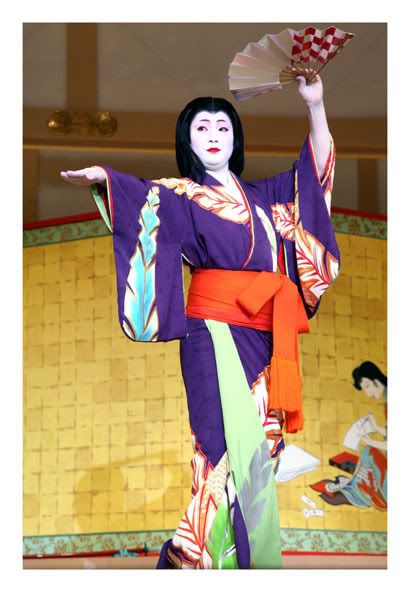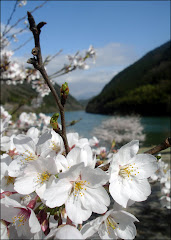 Commemorating the 400th anniversary of Hikone Castle, the third scene was based on the famous folding screen, once owned by a Hikone Daimyo (feudal lord) from the Ii family. The screen, believed to have been created between 1624 and 1644, is considered one of the best Japanese genre paintings andhas been designated as a national treasure.
Commemorating the 400th anniversary of Hikone Castle, the third scene was based on the famous folding screen, once owned by a Hikone Daimyo (feudal lord) from the Ii family. The screen, believed to have been created between 1624 and 1644, is considered one of the best Japanese genre paintings andhas been designated as a national treasure. 
The Kabuki Actress: Today, Kabuki is famous for it's lack of actresses, and the peculiar male actors who specialize in portraying women (onnagata). It was a young shrine maiden named Okuni, however, who first began performing the wild new style of dance drama in Kyoto's dry Kamo riverbed in 1603. Female performers portrayed both men and women in comic playlets about everyday, ordinary life. The style was an instant hit, popular with the masses and eventually, nobility. Okuni was invited to perform before the Imperial Court, inspiring the formation of rival troupes in the wake of such success. Much of its appeal was due to the suggestive performances put on by many troupes, further augmented by the fact that the performers were often also available for prostitution. In fact, kabuki was often written with the characters for song, dance, and prostitute during the Edo Period.

The scene began as the a beautiful golden screen depicting an ex-samurai, a Kabuki actress, two prostitutes and and a child of the pleasure quarters filled the theater with the atmosphere of Kyoto`s old pleasure quarters. One by one, each section of the screen turned to reveal a geiko dressed as the painting character, perfectly still and poised, until they stepped out of the folding screen and onto the stage, bringing the scene of life.
The ex-samurai seems to have been very popular...
 A young child of the pleasure quarters (on the right).
A young child of the pleasure quarters (on the right).







2 comments:
so interesting! it's the next best thing to being there!
Your photos are really amazing, way better than mine! Were you sitting in the front row or do you have a very powerful zoom lens :-)?
Post a Comment